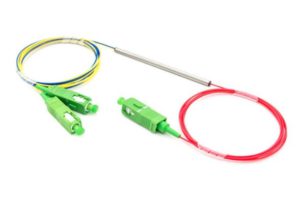Double Cladding Fiber Fused Coupler/Splitter
high back reflection collection efficiency using large core fiber, sensors, LiDAR
We offer one of the industry’s most comprehensive selections of fused fiber couplers and splitters, designed for a wide range of application scenarios. Backed by over 25 years of production and engineering expertise, our products deliver industry-leading performance, reliability, and cost-effectiveness.

| Center Wavelength | Spec | Available | Price for 1 | Buy |
| 780 nm | 5 weeks | $𝟪𝟫𝟣 | ||
| 1060 nm | 5 weeks | $𝟪𝟪𝟢 | ||
| 1310 nm | 5 weeks | $𝟣,𝟢𝟥𝟧 | ||
| 1550 nm | 5 weeks | $𝟣,𝟢𝟥𝟧 |

This device is intended to be used to collect the reflective light more efficiently via the thicker cladding layers while the smaller center core emits a sensing laser beam. The reflective lights in the cladding are further coupled into a large core fiber to guide the signal into a photodetector. We produce matching photodetectors. These double-clad fiber couplers can be used for many imaging and sensing applications, including LiDAR, Optical Coherence Tomography (OCT), Fluorescence Imaging, Confocal Microscopy, Surface Plasmon Resonance (SPR) Sensing, Speckle-Free Single-Fiber Endoscopy. The inner cladding of the fiber behaves like a pinhole in a confocal microscopy setup, preserving optical sectioning while increasing collection efficiency and reducing laser speckle. Additionally, this coupler can be used to combine optical coherence tomography (OCT) with fluorescence imaging, spectroscopy, or confocal microscopy. The diagram to the right depicts DCF cross-section structure. This unique feature can be utilized for sensor applications with improved light collection efficiency.
These 2×2 Double-Clad Fiber Couplers combine a double-clad fiber with a large core step-index multimode fiber. Light in the single mode core transmits with little loss over the 430 – 680 nm, 680 – 980 nm, 960 – 1260 nm, or 1250 – 1550 nm wavelength range. The multimode transfer efficacy, defined as the ratio of the output signal at large core multimode fiber Port 3 to the light intensity input at Port 2, is ≥60% over a wider wavelength range of 400 – 1750 nm, excluding the water absorption region around 1383 nm. Double-clad fiber couplers are well suited for applications at 530 nm, 780 nm, 1060 nm, or 1300 nm. The coupler structure is shown in Fig.2. Custom configurations using different DCF and coupling detector fiber are available.

Fig.2 application example- single mode probing laser, multimode reflection signal collection though a shared lens.
